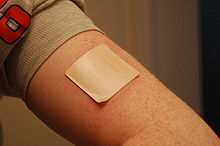Nicotine replacement products

A nicotine patch is applied to the left arm
|
|
| Clinical data | |
|---|---|
| Trade names | Nicoderm, Commit, Nicorette, Nicotrol, others |
| AHFS/Drugs.com | Monograph |
| Pregnancy category |
|
| Identifiers | |
|
|
| CAS Number | |
| PubChem CID | |
| ChemSpider | |
Nicotine replacement therapy (NRT) is a medically-approved way to take nicotine by means other than tobacco. It is used to help with quitting smoking or stopping chewing tobacco. It increases the chance of quitting smoking by about 50% to 70%. Often it is used along with other behavioral techniques. NRT has also been used to treat ulcerative colitis. Types of NRT include the adhesive patch, chewing gum, lozenges, nose spray, and inhaler. The use of more than one type of NRT at a time may increase effectiveness.
Common side effects depend on the formulation of nicotine. Common side effects with the gum include nausea, hiccups, and irritation of the mouth. Common side effects with the patch include skin irritation and a dry mouth while the inhaler commonly results in a cough, runny nose, or headaches. Serious risks include nicotine poisoning and continued addiction. They do not appear to increase the risk of heart attacks. There are possible harms to the baby if used during pregnancy. Nicotine replacement therapy works by reducing cravings due to nicotine addiction.
They were first approved for use in the United States in 1984. Nicotine replacement products are on the World Health Organization's List of Essential Medicines, the most effective and safe medicines needed in a health system. They are available as generic medication. In the United States a month of patches or gum is between 100 and 200 USD while the other forms are more expensive.
...
Wikipedia
